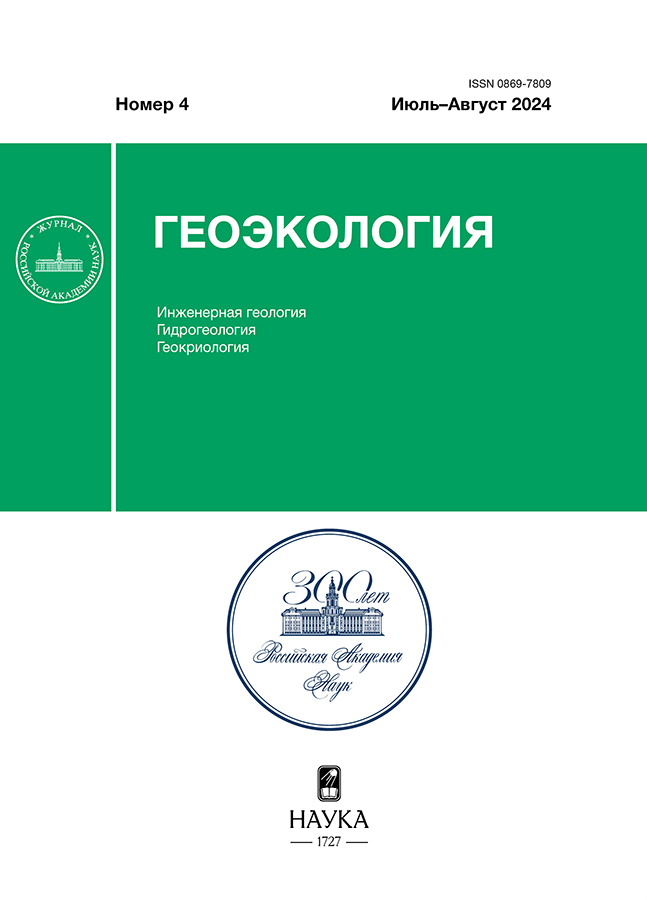Neostructural zoning and hazardous processes in the Chara rift basin
- Авторлар: Nesmeyanov S.A.1, Sergeev D.O.1, Voeykova O.A.1, Kulakov A.P.1
-
Мекемелер:
- Sergeev Institute of Environmental Geoscience, Russian Academy of Sciences
- Шығарылым: № 4 (2024)
- Беттер: 14-28
- Бөлім: NATURAL AND TECHNONATURAL PROCESSES
- URL: https://journals.eco-vector.com/0869-7809/article/view/660631
- DOI: https://doi.org/10.31857/S0869780924040025
- EDN: https://elibrary.ru/SFZETT
- ID: 660631
Дәйексөз келтіру
Аннотация
Routine distinguishing of morphostructures upon neotectonical studies in the Chara rift area is supplemented by the orotectonic method. This combination permitted us to characterize the phases and unevenness of orogenesis and faulting along the regional normal fault. The instability of Mesozoic and recent structure formation is revealed, as well as the Neo-Pleistocene activation of the structures known in Alpine orogens. It is shown that the structurally dependent features of the relief control the specifics of exogenous geohazards manifestation. Using the tectonic method, the established patterns may also be valid for other rifts in the Baikal Rift Zone.
Негізгі сөздер
Толық мәтін
Авторлар туралы
S. Nesmeyanov
Sergeev Institute of Environmental Geoscience, Russian Academy of Sciences
Хат алмасуға жауапты Автор.
Email: voa94@mail.ru
Ресей, Ulanskii per. 13, bld. 2, Moscow, 101000
D. Sergeev
Sergeev Institute of Environmental Geoscience, Russian Academy of Sciences
Email: sergueevdo@mail.ru
Ресей, Ulanskii per. 13, bld. 2, Moscow, 101000
O. Voeykova
Sergeev Institute of Environmental Geoscience, Russian Academy of Sciences
Email: voa94@mail.ru
Ресей, Ulanskii per. 13, bld. 2, Moscow, 101000
A. Kulakov
Sergeev Institute of Environmental Geoscience, Russian Academy of Sciences
Email: cryolithozone@mail.ru
Ресей, Ulanskii per. 13, bld. 2, Moscow, 101000
Әдебиет тізімі
- [Geology and seismicity of the BAM zone. Neotectonics]. Novosibirsk, Nauka Publ., 1984, 208 p. (in Russian)
- Endrikhinskii, A.S. [Development of the river network of the Stanovoi Highlands in the Late Cenozoic]. In: [Relief and Quaternary deposits of the Stanovoi Highlands]. Moscow, Nauka Publ., 1981, pp. 135–166. (in Russian)
- Enikeev, F.I. [Pleistocene glaciations of the Eastern Transbaikalia and the southeast of Central Siberia]. Geomorfologiya, 2009, no. 2, pp. 33–49 (in Russian)
- Enikeev, F.I. [Late Cenozoic of Northern Transbaikalia and paleoclimate in the south of the Eastern Siberia]. Geologiya i Geofizika, 2008, vol. 49, no. 8, pp. 794–804. (in Russian)
- Levi, K.G., Kul’chitskii, A.A. [Leveling planes of the northeastern part of the Baikal rift zone]. In: [Relief and Quaternary deposits of the Stanovoi Highlands]. Moscow, Nauka Publ., 1981, pp. 19–35. (in Russian)
- Logachev, N.A. [Sedimentary and volcanogenic formations of the Baikal rift zone]. In: [Baikal Rift]. Moscow, Nauka Publ., 1968, pp. 72–101. (in Russian)
- Lopatin, D.V. [Geomorphology of the eastern part of the Baikal rift zone]. Novosibirsk, Nauka Publ., 1972, 115 p. (in Russian)
- Lopatin, D.V. [About leveling planes and processes in the eastern part of the Baikal rift zone]. In: [Leveling planes]. Moscow, Nauka Publ., 1973, pp. 211–217. (in Russian)
- Nesmeyanov, S.A. [Engineering geotectonics]. Moscow, Nauka Publ., 2004, 780 p. (in Russian)
- Nesmeyanov, S.A. [Quantitative assessment of the latest movements and non-structural zoning of the mountain region)]. Moscow, Nedra Publ., 1971, 144 p. (in Russian)
- Nesmeyanov, S.A. [Orotectonic method]. Moscow, Mittel Press, 2017, 376 p. (in Russian)
- [Plateaus and lowlands of Eastern Siberia]. Adamenko, O.M., Ed., Moscow, Nauka Publ., 1971, 320 p. (in Russian)
- [Natural conditions of the development of the Chita region north]. Nedeshev, A.A., Preobrazhenskii, V.S., Eds., Moscow, AN SSSR Publ., 1962, 127 p. (in Russian)
- Ravskii, E.I. [Sedimentation and climates of the Inner Asia in Anthropogene]. Moscow, Nauka Publ., 1972, 336 p. (in Russian)
- Ufimtsev, G.F. [Mountain belts of continents and the relief symmetry]. Novosibirsk, Nauka Publ., Siberian division, 1991, 160 p. (in Russian)
- Ufimtsev, G.F. [Morphotectonics of Eurasia]. Irkutsk, IGU Publ., 2002, 494 p. (in Russian)
- Florensov, N.A. [Mesozoic and Cenozoic depressions of the Baikal region]. Moscow, Leningrad, AN SSSR Publ., 1960, 258 p. (in Russian)
- Sherman, S.I., Dem’yanovich, V.M., Lysak, S.V. [Seismic process and modern multilevel destruction of the lithosphere in the Baikal rift zone]. Geologiya i Geofizika, 2004, vol. 45, no. 12, pp. 1458–1470. (in Russian)
Қосымша файлдар























